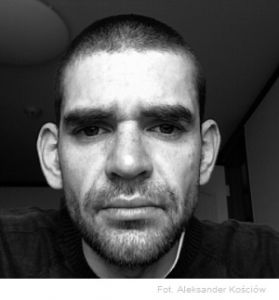Kościów Aleksander
-
composer
composer, b. 5th May 1974 in Opole. In the years 1993-98 he studied composition with Marian Borkowski (diploma with distinction) and between 1994 and 1998 – viola with Błażej Sroczyński at the Academy of Music in Warsaw. In 2007 he obtained a doctor’s degree in composition (supervisor –Marian Borkowski).
He was awarded in several competitions for composers, e.g. in Katowice (1991 – an honourable mention), Tychy (1992 – finalist), Warsaw (1995 – an honourable mention, 1998 – an honourable mention, 1999 – 1st prize, 2000 – an honourable mention), Częstochowa (1996 – an honourable mention), Gdańsk (1997 – 3rd prize), Cracow (1999 – 1st prize) and Katowice (2000 – main award). In 2004 he was granted a Fulbright Foundation scholarship (Junior Grant). Aleksander Kościów’s works have been performed both in Poland and abroad (Germany, England, Scotland, Russia, Ukraine, France, Italy, Japan, South Korea and the USA).
He has worked as a lecturer at the F. Chopin Academy (now the University) of Music in Warsaw since the academic year 1998/99. He was also a guest lecturer in San Diego (USA), Weikersheim (Germany) and Taegu (South Korea). In 1999 he started cooperation with Joe Alter – an American contemporary ballet choreographer. Since 2009 he has been collaborating with the socio-cultural bimonthly “Strony” (“Sides”) edited by Jan Feusette.
In the years 1996-98 Aleksander Kościów held the position of secretary of the Polish Composers’ Union’s Youth Circle. In 2002 he became a member of Polish Composers’ Union, “Contemporary Music Laboratory” Society and the Phonographic Academy.
A CD dedicated exclusively to his works was released by the Polish Composers’ Union / Polish Music Information Centre (in co-operation with the Polish Radio and with the financial support of the Ministry of Culture and National Heritage) in 2013 as part of the “Polish Music Today – Portraits of Contemporary Polish Composers”
Author of novels: The World of the Loon (2006), Say Sorry. A Player’s Manual (2008), Whales Flying (2010), as well as short stories.
updated: 2013 (iz)
Creation
To the Polish public and critics, Aleksander Kościów seems to be much better known as a writer than as a composer , even though the latter is both his acquired and actual profession. This is undoubtedly the result of the very warm reception accorded to three of his novels (Świat nura [The World of the Loon], 2006; Przeproś. Przewodnik gracza [Say Sorry. A Player’s Manual], 2008, nominated for the ‘Passport’ Award of the ‘Polityka’ Weekly; Lecą wieloryby [Whales Flying], 2010). Recently, however, as the artist himself reveals, “literature returned to the place it has probably always occupied in my life – namely, that of a seriously taken hobby”, while he began to spend more time composing music. All the same, Kościów’s peculiar double identity as an artist provokes questions about the mutual relation of both types of activity, or, in a wider context – about the cultural and communicative space in which books and music interact. The composer himself views that space as “an ontological universe”, “a shimmering whole” in which “literature and music, rhetoric and the logic of nature, strategy and game theory, the miracle of parenthood and higher mathematics – meet and interpenetrate.” A section of that whole is “told” to the audience as a result of the creative act.
(...) Whether I compose music or put words together, I deal with matter that simultaneously sings, plays, speaks, visualises itself, smells and happens in time as a kind of ∞-dimensional imagined landscape,” says the composer, stressing that the choice of medium and tools are of secondary importance in this approach – a sort of necessary “work to be done in the physical world”. This way of thinking naturally leads to interactions between thinking about music in terms of verbal rhetoric and, conversely, creating certain “resonances” between these two different languages, for instance – on the level of form, of planning the culminations and turning points in the “action”, that is, of those elements that direct and guide the audience’s perception.
Tracing those elements in the music performance is an ambitious task that attentive listeners to Kościów’s compositions can set themselves; still, this is not the composer’s chief purpose. He constructs multidimensional “landscapes of sensations” which can be experienced without a conscious act of perception supported by the inherited European rationality or, as the artist himself describes it – without “navigation using the tools of knowledge.” The intended audience of Kościów’s music is “a man in a kind of hypnotic state floating in the world of the subconscious (dream, dreaming, belief, a threshold experience), but at the same time plugged into the crucial cultural and emotional topoi”: one that can gain an insight into the very essence and meaning of the musical aspect of the composition.
Let us now move to the, so to speak, “key secondary matters” – to the means that the composer applies to create his musical landscapes. One striking feature of his music is its “impressionist” nature: the delicacy of sound, subtle choice of colours and textures. Kościów’s sound palette is usually dominated by shades of just one colour – a far cry from “the Amazon extravaganza and the rainbow of a great city’s colours”. Among his “secret and favourite paintbrushes”, we will find e.g. the female voice (as in Shihaikai), “a clarinet group” (as in Symphony and Lithaniae) or a string quartet. Kościów does not treat his quartets, however, as an attempt at redefining that crucial historical genre, still so popular in contemporary music. Instead, he views the string quartet’s “way of being and operating” as “a certain form of expression reserved for some exceptional situations”, “an autotelic medium ”, or even “a kind of diary or sailing directions, an itinerarium or a chronicle.” His Quartet No. 3 is, as he claims, “a musical memento of the first period of establishing my own, independent priorities (mostly related to textural techniques and the concept of form), many of which influenced my later decisions, and some have even remained valid until today.”
The composer always subordinates the choice of musical media to the overall “textural- tmospheric situation”. His preferred moods, reflected in his musical landscapes, are imbued with peace, deep spirituality, and a sense of mystery. This is distinctly reflected in the titles he gives to his works. As the composer explains: “In my music, a title is for the work what the design of an object or situation is for the need that brings the designed object into existence.” The title, depending on the idea and semantic content of the piece, is a (semiological) sign of the composition’s senses and contents, and – on a second level – a suggestion or carrier of those senses and contents. For instance, the aim of titling a work Shihaikai (Four Haiku) is “to touch several Japanese landscapes with the indigenous senses rather than cramming them into our literality and the peculiar phonetic shape of Polish numerals.” The effect of this title is the purity of the transmitted sense of the piece. The range of associations suggested by the Latin title Liber sub cortice scriptus translates, in turn, into meanings not fully comprehensible to the listener (“the book inscribed under the bark”), but supplies the music in this way “with a mood of no less value, generated by half realised figures and images: a monastic scribe, a medieval monastery, Europa christiana, a palimpsest, imago mundi, etc.” In Voces (Voices), the use of Latin points to the literal meaning of the title (the ancient Roman name for tablets with charms and for a technique of composing spells) as well as – as the author’s travesties, “a certain ethos of casting spells on the world through language by cramming the physicality of language (letter shapes and sounds, vowel-consonant tensions) into an alternative form of being: geometry, symmetry, architecture, breaking language up into atoms and forming derivative reconstructions of that language for extralinguistic reasons: glottolalia, ideolalia, incantamenta.”
Conversely, in such works as Kyrie and String Quartet No. 3 the titles provoke no associations other than those related to genres known from music history. This leads us to the question of the composer’s artistic heritage, or his “rooting” in some specific cultural and musical traditions. Rather than supplying the composer with any permanent or precisely realised models or conventions to be implemented in his own work, tradition has provided impulses for entirely original explorations and artistic choices. It is a cliché to say that the situation of the contemporary composer, confronting the claim that “there can be nothing new” and overwhelmed by the immense mass of possibilities in postmodern art, is extremely difficult. But for Aleksander Kościów, this great variety of stylistic, linguistic and climatic “soils from which his art has absorbed nutrients and in which it perfected its DNA” is “one of the fundamental factors that determine ‘serious’ choices in the composer’s work.”
For Kościów, the historical space – extending over medieval and Renaissance music, Bach’s baroque, Mahler’s and Brahms’s symphonic art, selected compositions by Shostakovich, Bartók and Stravinsky, Webern’s aphoristic forms, the minimalist concepts of Górecki, Pärt and Taverner, Mongol and Aboriginal folk music, the sacred music of Tibet and various pop music trends – has become a source of inspirations of different kinds and on many levels. Those inspirations are present in his soundscapes, but in the form of nuances, in a distinctly non-literal manner. The composer does not systematise his technical and aesthetic priorities. Still, his music does demonstrate some recurring, specific elements which become the components of his aurally recognisable, individual style.
Most of all, however, the music of Aleksander Kościów – rumbling like an underwater volcano in Voces or glittering with sparkling harmonics in Quartet No. 3 and with suggestive archaisms in Kyrie – draws upon the universal idea of beauty, thus providing the listeners with genuine aesthetic pleasure. “Considering the high standard of his literary debut, Świat nura [The World of the Loon], it is quite likely that Kościów may soon become better know as a writer than a composer,” wrote Dorota Szwarcman in “Polityka” in 2006. We can only hope that this CD dedicated entirely to his compositions will contribute to his becoming no less widely recognised and successful as a composer.
(Unless stated otherwise, all the quotations come from an email interview with Aleksander Kościów conducted by the author of this essay in the 2nd half of July 2013.)
Iwona Lindstedt
(essay in CD booklet "Polish Music Today - Portraits of Contemporary Polish Composers - Aleksander Kościów"
polmic 098 / PRCD 1750)
Compositions
Motet I: ”My Heart Overflows with a Goodly Theme” (Ps. 45) for mixed choir and percussion instruments (1991)
Sonata for classical guitar solo (1991)
Motet II: ”O Lord, Rebuke Me Not in Thy Anger” (Ps. 38) for baritone and instrumental ensemble (1992)
Tritetron for female voice solo (1993)
String Septet for 2 guitars, 2 harps, 2 harpsichords and piano (1994)
Three Songs to Ritual Texts in Old Celtic Language for mixed choir a cappella (1994)
Partita for chamber orchestra (1994)
Musica Pulla for 3 bassoons and oboe (1994)
Miserere for mixed choir a cappella (1994)
Musica Fusca for 3 bassoons, contrabassoon, 3 cellos, double bass and percussion (1994)
Strophes for flute and violin (1995)
Musica Viridis for percussion ensemble (1995)
Sous-Entendu for viola solo (1995)
String Quartet No. 1 (1995)
Nanda Devi for 4 trumpets and percussion (1996)
Forsaken Gardens Are Full Of Weird Nooks for instrumental ensemble (1996)
Musica Caesia for instrumental ensemble (1996)
Fantasia for viola solo (1996)
String Quartet no 2 (1996)
Krystus zmartwych wstał je (Christ from Death Is Risen) for mixed a cappella choir (1996)
Agnus Dei for mixed choir a cappella (1996)
Partita for viola solo (1996)
Sonatina for viola and piano (1996-97)
Pezzo Sinfonico for symphony orchestra (1996-97)
Quinque carmina de aëre et aqua for 3 flutes and clarinet (1997)
St. John’s Eve for string orchestra (1997)
Dies Irae for tape (1997)
String Quartet No. 3 (1997)
Kyrie for mixed a cappella choir (1997)
Five Cosmogonic Tales for piano solo
(1997)Pressionata for violin solo (1997)
Tempestate Apparendorum for 4 cellists (1998)
Requiem Mundo for soprano, baritone, mixed choir and symphony orchestra (1998)
Ultra Exterum for solo piano (1998)
Déjà-vus Agonaux for violin and piano (1998)
Auqisagin Ermisalmu for solo piano (1998)
Liber Absens – String Quartet No. 4 (1999)
String Quartet No. 5 (1999)
Holometabol for instrumental ensemble (1999)
Elements for string orchestra (1999) (1999)
His... est Caritas na zespół kameralny (2000)
Three Postludes for piano solo
(2000)Four Songs for soprano and piano (2000)
Liber sub cortice scriptus for clarinet and string quartet (2001)
Lithiammokykliskia for solo violin
(2001)Thule for cello quartet (2001)
Kaleidergon for instrumental ensemble (2001)
Liber Figurarum Aquae for 2 pianos (2002)
String Quartet No. 6 (2002)
Hyalia for violin and piano
(2002)Nenia for clarinet and piano (2002)
Ilargia for accordion solo (2002)
Unde for mixed choir, percussion and string orchestra (2003)
Liber Ventinebulae na flet, klarnet, fortepian i kwartet smyczkowy (2003)
Gloria for mixed choir a cappella (2003)
Cludioculos na trzy flety, trąbkę, perkusję, akordeon, fortepian i smyczki (2003)
Canor Keneias for cello and electronic media (2003)
Liber Septem Serpentum Saligiæ – String Quartet No. 7 (2004)
Ore Osse Oculo for clarinet, marimba, piano, violin and cello (2004)
Omphalos for piano solo (2004)
Shihaikai for soprano and piano (2004)
23:59:59 for 2 cellos and piano (2005)
Voces for chamber orchestra (2005)
Dilexit for mixed choir, 2 oboes, 2 trumpets, 3 trombones, percussion and string instruments (2006)
Symfonia na chór i orkiestrę symfoniczną (2006)
Song on Light of Water for choir and orchestra (2007)
String Quartet No. 8
(2008)String Quartet No. 9 (2009)
Lenten Lamentations for female choir and 8 cellos (2010)
Duae molentes in mola for a cappella choir (2011)
Nebulae for 2 a cappella choirs (2011)
Dusk Music for clarinet, percussion, cimbalom, hurdy-gurdy, violin and double bass (2012)
Lithaniae na sopran, chór żeński głosów białych i orkiestrę (2012)
String Quartet No. 10 (2012-13)
Iffy Shapes for saxophone, accordion and cello (2013)
Święty Jacek, 02.09.44 na insterumenty dęte i perkusję (2014)
Tnyganekuinlu na sekstet wokalny (2014)
Thereisa Street na zespół akordeonów (2014)
Steam Punk Gear na organy Hammonda i perkusję (2014)
Wielki Kanon do tekstu Statutu Związku Kompozytorów Polskich na chór (2015)
Oberek for Terry Riley na kwartet smyczkowy (2015)
Krajobrazy młodoplskie na sopran, wiolonczelę i fortepian (2015)
O, Call Not Me na sekstet wokalny (2015)
Many Cities na sopran i zespół (2016)
Hílathi na kwartet smyczkowy (z ewentualnym chórem mieszanym lub żeńskim) (2016)
Huascarán na skrzypce i perkusję (2016)
The Book of Teraa na sekstet wokalny i electric piano (2016)
Kantata o Chrzcie Polski na chór mieszany, trzy klarnety, trzy puzony, trzech perkusistów, fortepian, siedem wiolonczel i kontrabas (2016)
Noumen 1 na dwa fortepiany i perkusję (2017)
Kwintet na obój i kwartet smyczkowy (2017)
Koncert na akordeon i orkiestrę (2019)
Hodos/Oikos - koncert na elektryczny kwartet smyczkowy i orkiestrę kameralną (2020)
Stage music
Music for the play Hecuba, dir. by Karolina Labakhua’s, based on Euripides (2011)
Literature
Szymańska-Stułka Katarzyna, Kościów Aleksander Janusz, in: Almanach Kompozytorów Akademii Muzycznej im. F. Chopina w Warszawie [An Almanac of Composers of the Fryderyk Chopin Music Academy in Warsaw, in Polish], Volume One, Akademia Muzyczna w Warszawie, Warszawa 2004











